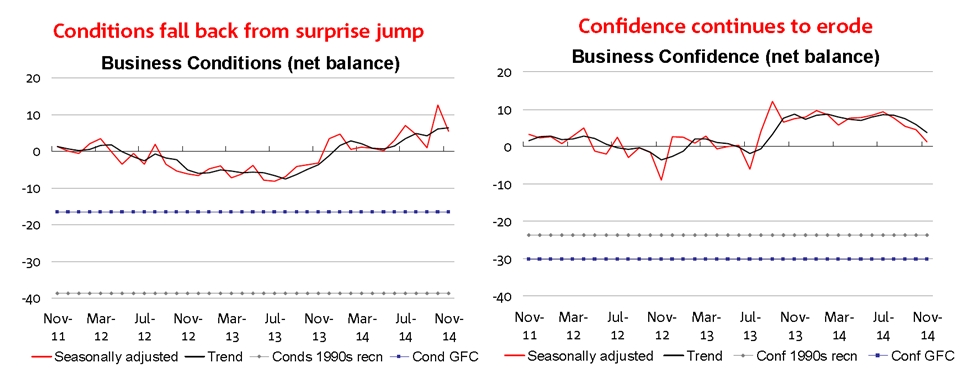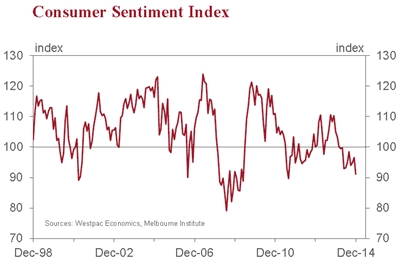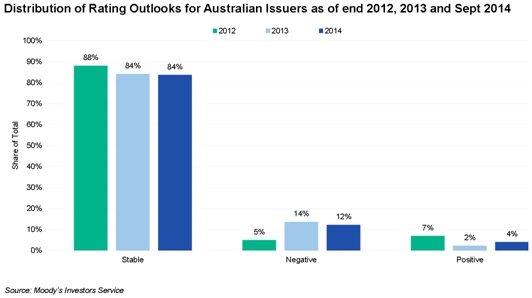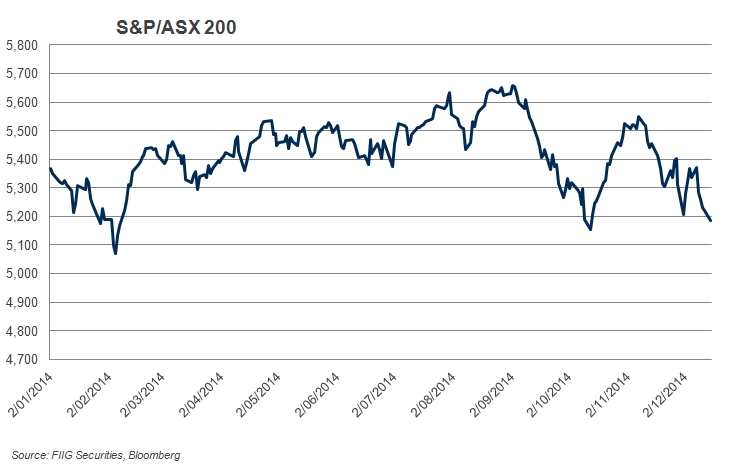by
William Arnold | Dec 16, 2014
Key points:
- Australian government bond yields have fallen to their lowest level this year, as buyers positions themselves against low inflation and expected cuts in the cash rate in 2015.
- The Westpac-Melbourne Institute Consumer Sentiment Index fell to its lowest level for more than three years with a 5.7% fall from 96.6% in November to 91.1% in December, with respondents concerned about the outlook for the economy and job security.
- Further monetary stimulus in the form of a lower $A and the likelihood of further RBA interest rate cut(s) should see improving conditions in sectors like housing construction, consumer spending, tourism, manufacturing and higher education.
- If you consider the outlook to be negative, it may be time to take profits from higher risk or more exposed businesses and de-risk into a more defensive position.
- If you want to take a more defensive position by investing in investment grade credits which offer attractive returns, Sydney Airport, Envestra, NAB Capital Instruments, Swiss Re, Civic Nexus and JEM (Southbank) are worth considering.
As the year comes to an end, Australian business conditions have declined, consumer sentiment is at its lowest point in three years and the outlook remains modest. A slew of gloomy economic news and indicators in recent weeks, and regulator plans to crack down on lending to property speculators, have raised expectations of further monetary easing by the RBA. Australian government bond yields have fallen to their lowest level this year as buyers positions themselves against low inflation and expected cuts in the cash rate in 2015. Forward swap rates point to at least one 25 basis point reduction next year and a strong chance of a second. An April cut is priced in as a 96% chance.
Business conditions
According to the closely followed NAB monthly business survey, confidence declined to the lowest level in 16 months with the index falling to 1 in November from 5 in the previous month. The business conditions indicator, a measure of employment, sales and profits, fell to 5 from 13, driven by a decline in all three components. The retreats in NAB’s indices were largely concentrated in retail, manufacturing and service industries, with companies being uncertain about outlook for their industries.

Figure 1
Based on past relationships, wholesale conditions have been a good predictor of overall business conditions, exhibiting strong statistical evidence of a leading relationship. Wholesale conditions remain well into negative territory at -11, continuing the trend with 26 of the last 27 months showing negative numbers.
Demand for commercial credit has also reversed (an indicator of businesses growth expectations), shown by monthly flow data from the Australian Bureau of Statistics. Commercial finance commitments fell 2.2% to $9.6bn in October from September on a seasonally adjusted basis.
New commercial loans in October were around 15% less than the $47bn level reported in June and July, and are back to monthly demand reported early in 2014.
Consumer sentiment
The Westpac-Melbourne Institute Consumer Sentiment Index fell to its lowest level for more than three years with a 5.7% fall from 96.6% in November to 91.1% in December, with respondents concerned about the outlook for the economy and job security. Consumer sentiment around house prices had soured with the survey showing waning interest in new mortgages from both owner occupiers and investors after a year of significant price growth, particularly in Melbourne and Sydney.

Figure 2
One measure of household credit demand is also soft. Recent data from the Reserve Bank of Australia shows accruing credit card balances declined by $667m over October from September to $33.4bn. This is 1.5% below the October 2013 level and their lowest point since December 2009. This is another indicator that consumers are being cautious and reducing debt rather than spending on discretionary items.
Credit rating outlook for Australian corporates
According to Moody’s over 80% of Australian corporate rating outlooks are stable, but the proportion of companies on negative outlook versus those on positive outlook indicates a negative bias. Negative rating actions are likely to continue to dominate in 2015.

Figure 3
Impact on industry
Such conditions are likely to translate to downgrades to or underwhelming corporate earnings in 2015 as businesses are impacted by lower commodity prices and a generally slowing domestic economy. Australia’s share market is heading for its first annual loss in three years as a slowdown in China and an oversupply of commodities weighs on the resources sector and weakening currency reduces demand for high yielding equities like banks. The index is currently down some 3.3% since the start of the calendar year.

Figure 4
So far, very low interest rates have mainly resulted in higher property prices rather than the desired broader improvement in economic activity. However, further monetary stimulus in the form of a lower $A and the likelihood of further RBA interest rate cuts should see improving conditions in sectors like housing construction, consumer spending, tourism, manufacturing and higher education.
High yield bond market
It is also worth noting that the Australian high yield bond market has remained buoyant in the face of growing volatility. Typically, higher yield investments exhibit higher volatility at time of market uncertainty/negativity. It therefore may be time to consider taking profits from higher risk or more exposed businesses if you consider the outlook to be negative and de-risking into a more defensive position. As always, diversification is key. Investors can endeavour to manage risks by diversifying their holdings across issuers, industries and regions and by monitoring each issuer’s financial health. Further to this, high yield bonds typically have a lower correlation to investment grade fixed income sectors, such as Treasuries and highly rated corporate debt, which means that adding high yield securities to a broad fixed income portfolio may enhance portfolio diversification. Diversification does not insure against loss, but it can help decrease overall portfolio risk and improve the consistency of returns.
While G8 Education is a solid credit, and generally relies on non-discretionary incomes, significant expansion intentions and the potential to continue to pay higher multiples on acquisitions may have a detrimental effect on its credit profile and therefore it looks fully priced. Coffey has a weak outlook and exposure to volatile Geoservices and therefore also looks fully priced.
Adani Abbot Point and Praeco are investment grade and are offering good value, while PMP has solid management executing a strong turnaround strategy and offers an attractive short term investment to first call in November 2015. Similarly, Mackay Sugar is relatively short dated and benefits from significant asset backing supporting its low risk credit profile. Cash converters has a positive outlook and is broadly countercyclical, typically growing its loan book driven by stressed financial positions.
If you want to take a more defensive position by investing in investment grade credits which offer attractive returns, Sydney Airport, Envestra, NAB Capital Instruments, Swiss Re, Civic Nexus and JEM (Southbank) are worth considering.
Copyright The contents of this document are copyright. Other than under the Copyright Act 1968 (Cth), no part of it may be reproduced or distributed to a third party without FIIG’s prior written permission other than to the recipient’s accountants, tax advisors and lawyers for the purpose of the recipient obtaining advice prior to making any investment decision. FIIG asserts all of its intellectual property rights in relation to this document and reserves its rights to prosecute for breaches of those rights.
Disclaimer Certain statements contained in the information may be statements of future expectations and other forward-looking statements. These statements involve subjective judgement and analysis and may be based on third party sources and are subject to significant known and unknown uncertainties, risks and contingencies outside the control of the company which may cause actual results to vary materially from those expressed or implied by these forward looking statements. Forward-looking statements contained in the information regarding past trends or activities should not be taken as a representation that such trends or activities will continue in the future. You should not place undue reliance on forward-looking statements, which speak only as of the date of this report. Opinions expressed are present opinions only and are subject to change without further notice.
No representation or warranty is given as to the accuracy or completeness of the information contained herein. There is no obligation to update, modify or amend the information or to otherwise notify the recipient if information, opinion, projection, forward-looking statement, forecast or estimate set forth herein, changes or subsequently becomes inaccurate.
FIIG shall not have any liability, contingent or otherwise, to any user of the information or to third parties, or any responsibility whatsoever, for the correctness, quality, accuracy, timeliness, pricing, reliability, performance or completeness of the information. In no event will FIIG be liable for any special, indirect, incidental or consequential damages which may be incurred or experienced on account of the user using information even if it has been advised of the possibility of such damages.
FIIG provides general financial product advice only. As a result, this document, and any information or advice, has been provided by FIIG without taking account of your objectives, financial situation and needs. Because of this, you should, before acting on any advice from FIIG, consider the appropriateness of the advice, having regard to your objectives, financial situation and needs. If this document, or any advice, relates to the acquisition, or possible acquisition, of a particular financial product, you should obtain a product disclosure statement relating to the product and consider the statement before making any decision about whether to acquire the product. Neither FIIG, nor any of its directors, authorised representatives, employees, or agents, makes any representation or warranty as to the reliability, accuracy, or completeness, of this document or any advice. Nor do they accept any liability or responsibility arising in any way (including negligence) for errors in, or omissions from, this document or advice. Any reference to credit ratings of companies, entities or financial products must only be relied upon by a ‘wholesale client’ as that term is defined in section 761G of the Corporations Act 2001 (Cth). FIIG strongly recommends that you seek independent accounting, financial, taxation, and legal advice, tailored to your specific objectives, financial situation or needs, prior to making any investment decision. FIIG does not make a market in the securities or products that may be referred to in this document. A copy of FIIG’s current Financial Services Guide is available at www.fiig.com.au/fsg.
An investment in notes or corporate bonds should not be compared to a bank deposit. Notes and corporate bonds have a greater risk of loss of some or all of an investor’s capital when compared to bank deposits. Past performance of any product described on any communication from FIIG is not a reliable indication of future performance. Forecasts contained in this document are predictive in character and based on assumptions such as a 2.5% p.a. assumed rate of inflation, foreign exchange rates or forward interest rate curves generally available at the time and no reliance should be placed on the accuracy of any forecast information. The actual results may differ substantially from the forecasts and are subject to change without further notice. FIIG is not licensed to provide foreign exchange hedging or deal in foreign exchange contracts services. The information in this document is strictly confidential. If you are not the intended recipient of the information contained in this document, you may not disclose or use the information in any way. No liability is accepted for any unauthorised use of the information contained in this document. FIIG is the owner of the copyright material in this document unless otherwise specified.
The FIIG research analyst certifies that any views expressed in this document accurately reflect their views about the companies and financial products referred to in this document and that their remuneration is not directly or indirectly related to the views of the research analyst. This document is not available for distribution outside Australia and New Zealand and may not be passed on to any third party without the prior written consent of FIIG. FIIG, its directors and employees and related parties may have an interest in the company and any securities issued by the company and earn fees or revenue in relation to dealing in those securities.